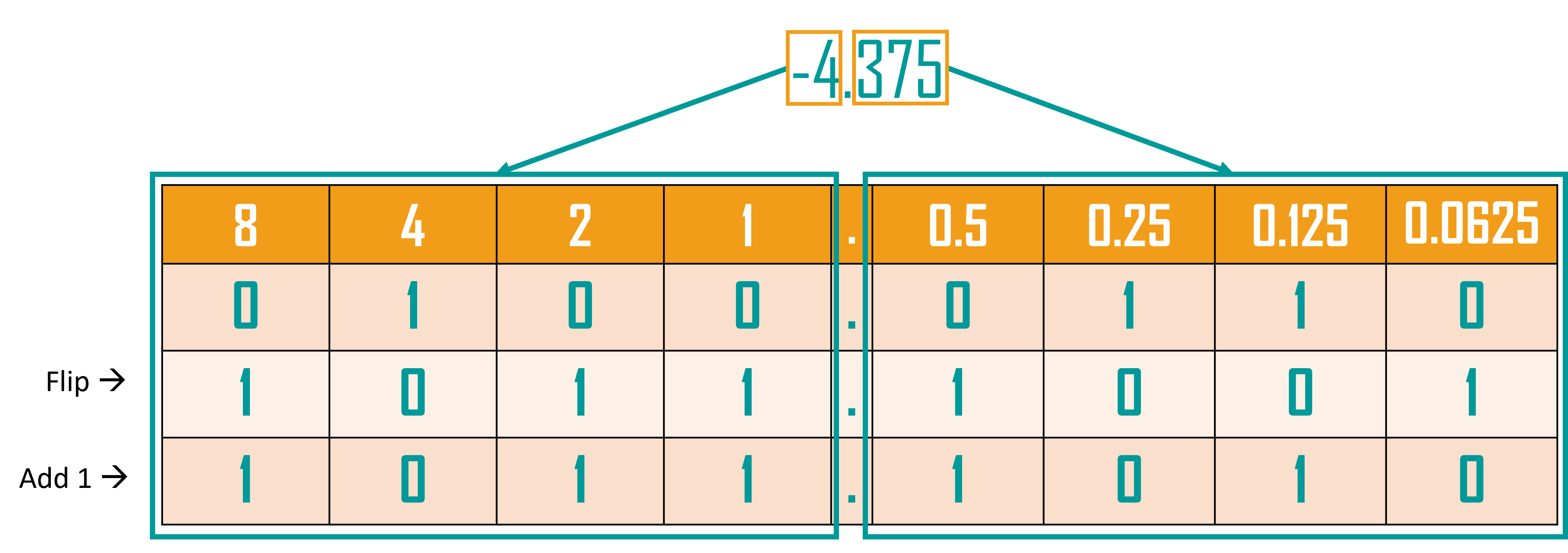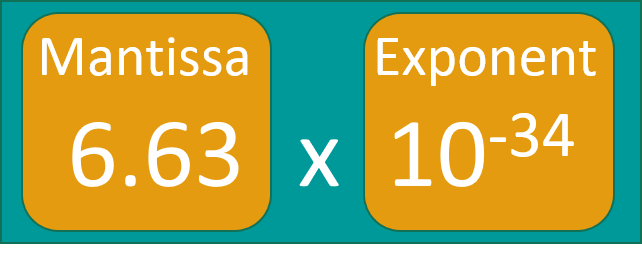|
12.1.1.6 use binary numbers with a fixed point to represent fractional numbers with a given number of bits. 12.1.1.7 represent positive and negative floating-point decimal numbers in binary. Fix point numbers and Floating point numbers I. Fixed point numbers Real number - a number with a fractional part.
The number 68.25 represents 6 tens, 8 units, 2 tenths, 5 hundredths. In binary, the equivalent place values are 128 64 32 16 8 4 2 1 . 1/2 1/4 1/8 1/16 The number 68/25 can be expressed as 68 + 1/4, and using the place values above converts to
Matching binary fractions and decimal fraction
Examples. Using one byte to hold each number, with an imaginary binary point fixed after the fourth digit, convert the following unsigned decimal numbers to binary. 5.7510 = 0101.11002
-4.37510 = 1011.10102
II. Floating point numbers Why do we use float point real numbers? 1) a very large number 600 000 000 000 000 = 0.6 х 1015 2) a very small number 0.000 000 000 03 = 0.3 х 10-10 Example of a denary floating-point number
Example of a binary floating-point number
Why use binary floating-point numbers Fixed-point binary allows computers to represent fractions but has a limited range. Even with 4 bytes (32 bits) and 8 bits for the fractional part, the largest representable number is just over 8 million. This limitation makes it unsuitable for very large numbers. Floating-point notation overcomes this by using a mantissa (main digits) and an exponent (position of the decimal point), similar to scientific notation in decimal. For example, 0.12 × 10¹⁵ has 0.12 as the mantissa and 10¹⁵ as the exponent. In binary, two bytes (16 bits) can be divided into 10 bits for the mantissa and 6 bits for the exponent, allowing a much wider range of numbers to be represented efficiently. Converting binary floating-point to decimal 1) Find the sign of the mantissa (write it down) 2) Write down the mantissa. If the mantissa is negative, convert the two's complement over it. 3) Find the exponent value. If the exponent is negative, convert the two's complement over it. 4) Move the floating point in the mantissa to the distance that defines the exponent (point 3), left for negative exponent, right for positive. 5) Calculate the whole part and the fractional part. Put a sign (point 1) Calculate the value of the number Example 1. Mantissa is positive, Exponent is positive
The mantissa m = 0.1001001002 The exponent e = 0001002 = 410 Therefore the value is 0.1001001002 x 24 = 1001.0012 = 9.12510 Example 2. Mantissa is negative, Exponent is positive
The mantissa is a negative value. Converting the two's complement gives m = - 0.0110111002 The exponent e = 0001002 = 410 Therefore the value is - 0.0110111002 x 24 = - 110.1112 = - 6.87510 Example 3. Mantissa is positive, Exponent is negative
The mantissa is m = 0.1010000002 The exponent is a negative value. Converting the two's complement gives e = - 0000102 = - 210 Therefore the value is 0.1012 x 2-2 = 0.001012 = 0.1562510 Example 4. Mantissa is negative, Exponent is negative
The mantissa is a negative value. Converting the two's complement gives m = - 0.1010000002 The exponent is a negative value. Converting the two's complement gives e = - 0000102 = - 210 Therefore the value is - 0.1012 x 2-2 = 0.001012 = - 0.1562510 Floating Point Binary Converter Normalisation float point numbers
Questions: Exercises: Ex. 1 Ex. 2 Ex. 3 Exam questions: | ||||||||||||||||||||||||||||||||||||||
|
| ||||||||||||||||||||||||||||||||||||||
| Просмотров: 8576 | | | ||||||||||||||||||||||||||||||||||||||
| Всего комментариев: 0 | |









